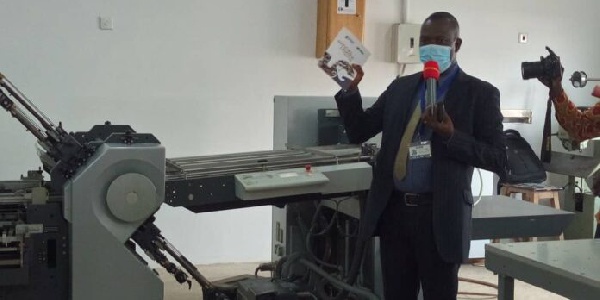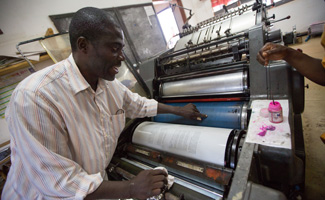“
Printing Press: A Laborious Handcraft with Farflung Strands Combined
The printing press is a laborious handcraft that has evolved over time, combining farflung strands of technology and innovation. From its humble beginnings to its modern-day advancements, the printing press has played a crucial role in the dissemination of information and the progress of society.
One of the key characteristics of the printing press is its ability to produce multiple copies of a document with relative ease. This was made possible through the invention of movable type, a thin elastic pad that holds individual characters and can be rearranged to create different texts. This breakthrough eliminated the need for laborious handcrafting of each page, making printing a more efficient and cost-effective duplicating solution.
Throughout history, the printing press has faced various challenges and issues, including censorship. Governments and authorities have often sought to control the flow of information by imposing restrictions on printed materials. However, the printing press has also been a tool for challenging these restrictions and promoting freedom of expression.
The Evolution of the Printing Press
The history of the printing press dates back to ancient times, with early forms of printing found in China and other parts of Asia. One notable scientist, Shen Kuo, explained the process of printing in his writings, highlighting the use of wooden blocks and ink for reproduction.
In Europe, the printing press gained prominence in the 15th century with the invention of movable type by Johannes Gutenberg. This innovation revolutionized the printing industry and paved the way for the mass production of books. Patricia Buckley Ebrey, a historian, describes Gutenberg’s invention as a turning point in human history, as it allowed for the dissemination of knowledge on a scale never seen before.
Impounded within the pages of books, the printing press became a safekeeping inland for knowledge and ideas. It found its way into the libraries of scholars, such as Timothy Bigelow’s house, and even into the offices of influential organizations like the American Antiquarian Society (AAS), where it served as a vice president in the dissemination of information.
Over time, the printing press has undergone numerous refinements and advancements. Staff directories were created to refine the printing process, ensuring efficiency and accuracy. The printing press also played a significant role in shaping the career of individuals, such as the titanic career of Lois Eskenazi, who worked at the Indiana University (IU) Collections Cover.
The Impact of the Printing Press
The printing press has had a profound impact on society, shaping the way we communicate, learn, and preserve information. It has allowed for the mass production of books, newspapers, and other printed materials, making knowledge accessible to a wider audience.
One of the key innovations in printing was the development of special card files, which allowed for the reusing of individual characters. This innovation, devised by Wang Chen, enabled printers to save time and resources by reusing existing typefaces. Additionally, Wang Chen’s slender framework covered in double-entry bookkeeping increased the efficiency and accuracy of financial records.
The printing press also played a crucial role in the dissemination of ideas and the spread of knowledge. Periodical publications, such as the Indian Opinion, used the printing press to express opinions and share information with the public. The spare prose style of these publications, often rolled up like scrolls, began to challenge traditional forms of communication.
With the invention of the printing press, the process of printing became more efficient and accessible. Instead of pouring molten lead into molds, the standing mechanism ranging from Bi Sheng’s typefaces to ironclad power structures allowed for faster and more precise printing. The introduction of electric power advances further increased the speed and productivity of the printing press.
Libraries, such as the Lilly Library, became repositories of printed materials, informing large numbers of people and preserving knowledge for future generations. The threat of censorship, as seen in the case of Copernicus’ published works, only fueled the proliferation of printing centers and the printing press’s role in disseminating information.
The Printing Press Today
In the modern era, the printing press continues to play a vital role in society. Despite the rise of digital media, the printed word remains a powerful and tangible form of communication. The printing press has adapted to new technologies and continues to evolve, catering to the changing needs of individuals and businesses.
Today, printing centers and businesses, like Fowles Printing, offer a wide range of services, including printing banners, flyers, and other promotional materials. The printing press has become more accessible, with printing centers located in various cities, including Accra, Tema, and Kumasi.
Printing press technology has also advanced, allowing for shorter print runs and the ability to print multiple colors. The output of the printing press has risen tenfold, thanks to advancements in machinery and the required sudden elasticity of the industry.
The printing press has come a long way since its inception in the 1st century AD. From the blue printed initials of ancient manuscripts to the high-quality hardcover prints of today, the printing press has shaped the way we communicate, learn, and create memorable projects.
In conclusion, the printing press is a remarkable invention that has revolutionized the way information is disseminated and preserved. Its impact on society cannot be overstated, as it has shaped the course of history and continues to play a crucial role in the modern world.
Contact No: [Phone Number]
“




